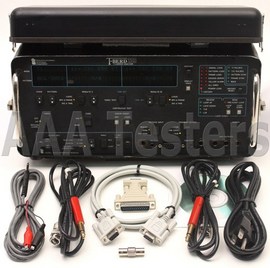
If you’re looking to Sell TTC T-BERD 209 JDSU T-Carrier Analyzer
For over a decade, telecom technicians have depended on the T-BERD 209 T-Carrier Analyzer’s no-nonsense approach to T1 testing. The T-BERD 209 is one of the most widely-used solutions for the spectrum of T1 troubleshooting and analysis needs. The reason is clear. TTC packs this user-friendly instrument with a robust feature set and backs it with a promise of customer care excellence.
Sometimes it makes sense to follow the crowd. When you need to test T1, you need a T-BERD–the tool whose name is synonymous with T1 testing.
Highlights
Auto configuration and results summary provide immediate identification of framing, pattern, and error status
Supports CSU/NIU emulation for isolation of customer premises and network equipment
Includes automated and user-configurable stress pattern testing
Performs G.821, B8ZS, and Fractional T1 error analysis
Measures and analyzes pulse shape
Brightly lit front panel display is ideally suited for low light testing environments
Lead acid battery enables technician to test anywhere for up to five hours without power generators or cords
Features
The T-BERD 2091 is a complete test and measurement solution for technicans who install, test, monitor, and maintain T1 links and equipment. The T-BERD 2091 can be optioned to perform the following tasks:
Equipment Installation
Verify proper circuit operation from point to point
Ensure that loopback equipment responds to designated loopcodes
Test equipment under different traffic conditions using built-in fixed and pseudorandom test patterns
Circuit Maintenance and Problem Isolation
Monitor the circuit for intermittent problems that may become more serious over time
Avoid the expense of taking the circuit out of service
Analyze live traffic without introducing any disturbances on the line
Identify and locate cable pair faults including shorts, bridge taps, load coils, and other line impairments
Out-of-Service Troubleshooting
Stress and analyze the network with point-to-point and loopback testing
Information that technicians need to ensure optimum T1 performance is readily obtained, quantified, and qualified by the T-BERD’s comprehensive testing and reporting options.
Pulse Shape Measurement and Analysis–Determine if the output of a network element is acceptable, and evaluate customer premises and network equipment adherence to pulse mask specifications at the point of sampling. Use DSX and network interface masks to measure pulse shape and width, rise time, fall time, undershoot, and overshoot.
Received Signal Level Measurements–Analyze signal strength to diagnose transmission problems caused by high/low signal levels.
G.821 Measurements–Perform error analysis per G.821 specification standards to verify circuit quality. Capture data including unavailable seconds, percent availability, degraded minutes, percent degraded minutes, severely errored seconds, percent severely errored seconds.
Stress Pattern Testing–Generate a full suite of patterns to rapidly locate and isolate line problems. Patterns include:
Automated Multipattern Tests
Detect elusive bridge taps using automated BRIDGTAP sequence and perform qualification tests with the user-configurable MULTIPAT® sequence
Long User Pattern
Stress repeater ALBO circuits with 55 OCTET, T1 DALY, and other long user test patterns
All Zero Stress Pattern
Identify circuits not configured for or incompatible with B8ZS data
Intelligent Repeater Loopcodes
Loop up and loop down individual addressable office repeaters and line repeators, or transmit maintenance switch commands
ESF Testing–Emulate and loop back network devices that accept either in-band or ESF out-of-band (data link) loopback codes with ESF framing. Decode ESF PRMs to confirm data link operation and network performance. Emulate ANSI T1.403 compatible CSU equipment during circuit installation and qualification.
Performance Monitor NIU–SMARTNIU mode queries the Performance Monitor portion of combined NIU/Performance Monitor equipment for the recorded T1 span statistics, sets the Performance Monitor NIU clock to match the T-BERD’s, and clears NIU performance results.
Buying, Selling, Trading TTC T-BERD 209
CSU/NIU Emulation–Isolate customer premises and network equipment during installation and maintenance.
B8ZS Detection–Quickly identify B8ZS encoded data via front panel indicator.
Fractional T1 Analysis–Perform bit error rate tests on selected channels to verify contiguous and non-contiguous bandwidth and route quality on FT1 circuits.
Specifications
Input and Output Connectors
Bantam
WECO 310
15-pin D
BNC
Input Impedance
BRIDGE: 1000 W with ALBO
TERM: 100 W with ALBO
DSX-MON: 100 W with AGC
Receive Level
BRIDGE or TERM:
+6 to -35 dBdsx (T1)
+3 to -6 dBdsx (T1C)
DSX-MON:
+6 to -24 dBdsx (T1)
+3 to -24 dBdsx (T1C)
Level Measurement
+6.0 to -40.0 dBdsx
+6.0 to -6.0; 0.1 dB resolution
-6.0 to -40.0; 0.5 dB resolution
Frequency Measurement
1 Hz resolution; 5 ppm accuracy
Transmit Timing Sources
Internal Clock
External Clock
Reference Clock
Recovered Clock
Line Codes
AMI
B8ZS
Loopback Codes
CSU
CSU Line (ESF)
CSU Payload (ESF)
NIU (FAC1, FAC2, FAC3)
NIU Network (ESF)
Programmable (3 to 8 bits)
Intelligent Repeaters
TDR Measurements
Pulse Amplitude: 10.0 Vp-p (nominal)
Pulse Frequency: 11.718 kHz (nominal)
Measurement Range: 100 to 10,000 ft
Pulse Masks
CB 119 (ANSI T1.102)
ANSI T1.403-1989
Wander Measurement
+99999 UI, 1 UI resolution
Power
115 VAC ± 10%, 50 to 60 Hz
Lead Acid Battery
Physical Characteristics
Enclosure Dimensions:
6.0 H x 13.5 W x 6.5 D in.
(38.7 H x 87.1 W x 41.9 D cm)
Weight:
10.0 lb (4.5 kg)
Operational Characteristics
Operating Time: 5 hours (nominal)
Charging Time: 8 hours (nominal)
Operating temperature: 32° to 109.8° F
(0° to 45° C)
Model 30554 Interface Module
Test and measurement solution for technicans who install, test, monitor, and maintain T1 links and equipment
T1 modes include:
Unframed, for compatibility with existing test equipment on circuits where framing is not required
Framed, for testing circuits which include multiplexers and Digital Access and Crossconnect Switches through which only framed data will pass – D4, ESF, and SLC-96 data formats
Test Loopback and Line Loopback, which simulate a CSUs loopback features and are useful when installing or troubleshooting T1 spans
If you’re selling your TTC T-BERD 209 please fill out form on the right hand side of page.